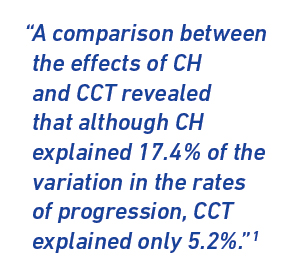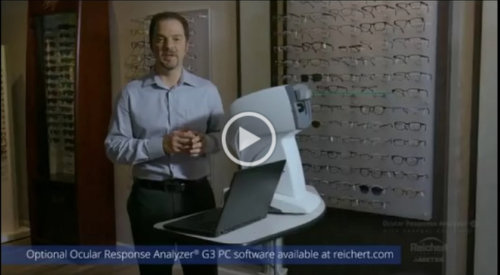The Reichert Ocular Response Analyzer (ORA) is the only device that measures Corneal Hysteresis (CH), a superior predictor of glaucoma progression. Corneal Hysteresis is an indication of the biomechanical properties of the cornea differing from thickness or topography, which are geometrical attributes.
“CH measurements are significantly associated with risk of glaucoma progression. Eyes with lower CH had faster rates of visual field loss than those with higher CH.”1
In addition to Corneal Hysteresis, Ocular Response Analyzer provides Corneal Compensated Intraocular Pressure (IOPcc), a better indication of the true pressure, proven to be less influenced by corneal properties than Goldmann or other methods of tonometry.2
Corneal Hysteresis (CH): An indispensable tool in the glaucoma decision making process.
Corneal Hysteresis has consistently shown to be predictive of, or strongly associated with, glaucoma progression, and more powerfully so, than key indicators such as IOP and CCT, making it an indispensable tool in the glaucoma decision making process.
Glaucoma is the second leading cause of irreversible blindness in the world. Despite the fact that there are a variety of well-known risk factors, it can be difficult to diagnose. Beyond diagnosing, predicting an individual patient’s rate of future glaucoma progression is often extremely challenging for clinicians.

The Ocular Hypertension Treatment Study (OHTS), and similar studies, have brought to light the relevance of central corneal thickness (CCT) in glaucoma. Numerous studies utilizing the Ocular Response Analyzer have confirmed the importance of the cornea in glaucoma decision making and, in fact, demonstrated that Corneal Hysteresis is of far greater significance than CCT.
How is Corneal Hysteresis measured?
Corneal Hysteresis is the difference in the inward and outward pressure values obtained during the patented dynamic bi-directional applanation process utilized by the Ocular Response Analyzer. It is a characterization of the cornea’s ability to absorb and dissipate energy, which is a function of visco-elastic biomechanical properties of the cornea.

Unparalleled user experience.
Measurements could not be quicker or simpler with Ocular Response Analyzer G3. A single touch of the intuitive user interface initiates a fully automated alignment and measurement, simultaneously displaying Corneal Compensated IOP (IOPcc), Corneal Hysteresis (CH), Goldmann correlated IOP (IOPg), and Waveform Score (WS).

Confidence, reliability and efficiency.
The advanced, patent-pending Waveform Score feature, combined with Reichert’s unique intelligent averaging technique, enhances measurement reliability and repeatability so operators can be confident in the accuracy of the measurement results. Operators can easily access all functions through the integrated touch screen display, including export of patient data for effortless EMR integration. Delegate your tonometry and Corneal Hysteresis measurements to trained technicians with ease.

The Role of Corneal Hysteresis in Glaucoma Progression, Felipe Medeiros, MD
Felipe Medeiros, MD, Professor at Duke Ophthalmology, describes his recent study using Corneal Hysteresis (CH) — a measure of the eye’s viscoelastic biomechanics properties — for predicting glaucoma progression. Dr. Medeiros explains the importance of collecting Corneal Hysteresis measurements to better determine patients at high risk for glaucoma.
See Additonal Information tab for more educational videos
CPT® Code 92145 published for Corneal Hysteresis.

A CPT code, 92145, has been published specifically for the Corneal Hysteresis measurement provided by the Reichert® Ocular Response Analyzer®. In the 2015 CPT handbook, a new, permanent, Category I CPT code, 92145 (Corneal hysteresis determination, by air impulse stimulation, unilateral or bilateral, with interpretation and report), replaces the prior temporary, Category III CPT code, 0181T. The new code took effect January 1, 2015. For more information regarding CPT Code 92145, please consult your medical billing specialist.
Footnotes
1 - Medeiros FA, Meira-Freitas D, Lisboa R, Kuang TM, Zangwill LM, Weinreb RN. Corneal hysteresis as a risk factor for glaucoma progression: a prospective longitudinal study. Ophthalmology. 2013 Aug;120(8):1533-40.
2 - Felipe A. Medeiros, MD and Robert N. Weinreb, MD. Evaluation of the Influence of Corneal Biomechanical Properties on Intraocular Pressure Measurements Using the Ocular Response Analyzer. J Glaucoma 2006;15:364–370.


Reprint from Reichert Technologies
Corneal Hysteresis Insights: ‘The Ophthalmologist’ Advanced Glaucoma Technologies Forum
Insights on the role of Corneal Hysteresis in Glaucoma management.
Taken from the Advanced Glaucoma Technologies Forum presented by The Ophthalmologist
“Hysteresis is a very powerful risk factor for progression of the disease, and I think it’s one that’s largely overlooked. In fact, if you take Hysteresis out of the central corneal thickness measurement, central corneal thickness might not even be a risk factor for glaucoma progression. Hysteresis is absolutely critical for estimating the risk.” – Robert Weinreb, MD.
Glaucoma opinion leaders Ike Ahmed, MD, E. Randy Craven, MD, Constance Okeke, MD, Inder Paul Singh, MD, and Robert Weinreb, MD, discuss the strides made in detection and management of glaucoma, and explain the benefits of measuring Corneal Hysteresis for glaucoma risk assessment. In this round table discussion, the doctors explain how Corneal Hysteresis aids them in better predicting glaucoma progression.
“Things like Hysteresis have helped me a great deal because it does give you an understanding of the quality of the IOP. In other words if someone has a low hysteresis with a high pressure I’m much more worried than having a high Hysteresis with a high pressure,” explains Dr. Singh.
Significance of Corneal Hysteresis in predicting glaucoma development in 25 seconds, Felipe Medeiros MD from Reichert Technologies on.
Felipe Medeiros, MD briefly describes the relevance of his new publication: A Prospective Longitudinal Study to Investigate Corneal Hysteresis as a Risk Factor for Predicting Development of Glaucoma. Corneal Hysteresis was found to be independently more predictive of conversion to glaucoma than other risk factors, including IOP and CCT.
Ocular Response Analyzer® in clinical practice, use and interpretation, Nathan Radcliffe, MD
Nathan Radcliffe, MD, demonstrates use of the Ocular Response Analyzer®, describes the measurement results, and discusses how the Corneal Hysteresis and IOPcc measurements impact glaucoma decision making. He also discusses delegation of the test to technicians, patient flow, and other practical issues in this informative video.
How is Corneal Hysteresis useful in glaucoma decision making, J. Thimons, OD.
Dr. James Thimons, OD, discusses the use of the Ocular Response Analyzer and the importance of its Corneal Hysteresis and IOPcc measurements in the monitoring, diagnosis, and treatment of glaucoma. Here learn what Corneal Hysteresis is, why it is an essential glaucoma risk factor, and how to incorporate this measurement into daily clinical practice. In addition, Dr. Thimons explains why corneal biomechanics influence IOP measurement accuracy and how the IOPcc measurement provides a better assessment of the true intraocular pressure.
Corneal Hysteresis and glaucoma patient management, Davinder S. Grover, MD, MPH
Davinder S. Grover, MD, MPH, speaks about Corneal Hysteresis (CH) as an assessment of the cornea's ability to absorb and dissipate energy, which is different from thickness or topography, which are geometrical attributes of the cornea. Corneal Hysteresis is independently predictive of visual field progression in glaucoma.
Corneal Hysteresis: Clinical Relevance in Glaucoma in 90 Seconds, N. Radcliffe, MD



 Reichert Ocular Response Analyzer Training Video
Reichert Ocular Response Analyzer Training Video